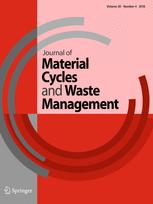Ver ítem
- xmlui.general.dspace_homeCentros e Institutos de InvestigaciónCICVyA. Centro de Investigación en Ciencias Veterinarias y AgronómicasInstituto de Microbiología y Zoología AgrícolaArtículos científicosxmlui.ArtifactBrowser.ItemViewer.trail
- Inicio
- Centros e Institutos de Investigación
- CICVyA. Centro de Investigación en Ciencias Veterinarias y Agronómicas
- Instituto de Microbiología y Zoología Agrícola
- Artículos científicos
- Ver ítem
Co-composting of poultry manure with other agricultural wastes: process performance and compost horticultural use
Resumen
The aim of this work was to evaluate the composting process of poultry manure mixed with other complementary organic wastes. Two mixtures (treatment 1 and 2) were prepared with corn bare cobs, sawdust, shavings and manure. Temperature, pH, electrical conductivity, organic matter loss, total organic carbon, solved organic carbon, N loss, ammonium and nitrate concentration, laccase activity and respiration indices were analyzed. These variables showed
[ver mas...]
The aim of this work was to evaluate the composting process of poultry manure mixed with other complementary organic wastes. Two mixtures (treatment 1 and 2) were prepared with corn bare cobs, sawdust, shavings and manure. Temperature, pH, electrical conductivity, organic matter loss, total organic carbon, solved organic carbon, N loss, ammonium and nitrate concentration, laccase activity and respiration indices were analyzed. These variables showed similar tendencies during the composting process in both treatments. A peak of biological activity, organic matter mineralization and salt release was observed after 6 days of the process. Treatment 2 showed a higher concentration of solved organic carbon and higher organic matter loss than in the mixture with less manure (treatment 1). Laccase activity increased when solved organic carbon decreased. Compost from treatment 1 showed lower phytotoxic effects than that from treatment 2, probably because of a low salt content. In conclusion, it was observed that 60 % content of poultry manure in the mixture does not affect the composting process. However, the final product is not as good for agricultural purposes as a mixture with a lower manure content. Finally, it can be stated that the valorization of these wastes in the form of compost adds value to the materials, closing the biogeochemical nutrient cycle.
[Cerrar]

Autor
Rizzo, Pedro Federico;
Della Torre, Virginia;
Riera, Nicolas;
Crespo, Diana Elvira;
Barrena, Raquel;
Sánchez, Antoni;
Fuente
Journal of Material Cycles and Waste Management 17 (1) : 42–50 (January 2015)
Fecha
2015-01
ISSN
1438-4957
1611-8227
1611-8227
Formato
pdf
Tipo de documento
artículo
Palabras Claves
Derechos de acceso
Restringido
 Excepto donde se diga explicitamente, este item se publica bajo la siguiente descripción: Creative Commons Attribution-NonCommercial-ShareAlike 2.5 Unported (CC BY-NC-SA 2.5)
Excepto donde se diga explicitamente, este item se publica bajo la siguiente descripción: Creative Commons Attribution-NonCommercial-ShareAlike 2.5 Unported (CC BY-NC-SA 2.5)
Metadatos
Mostrar el registro completo del ítemÍtems relacionados
Mostrando ítems relacionados por Título, autor o materia.
-
Integral approach for the evaluation of poultry manure, compost, and digestate: Amendment characterization, mineralization, and effects on soil and intensive crops
Rizzo, Pedro Federico; Young, Brian Jonathan; Pin Viso, Natalia Daniela; Carbajal, Jazmin; Martínez, Laura Elizabeth; Riera, Nicolas Iván; Bres, Patricia Alina; Beily, María Eugenia; Barbaro, Lorena Alejandra; Farber, Marisa Diana; Zubillaga, Marta Susana; Crespo, Diana Elvira (Elsevier, 2022-02-15)The egg industry has increased its production worldwide during the last decades. Several waste management strategies have been proposed to treat large volumes of poultry manure. Composting and anaerobic digestion are the ... -
Prácticas agroecológicas: compostaje de troncos residuales de la producción de hongos comestibles (Pleurotus sp.)
Barrionuevo, Myriam Elisabeth; Senger, Carmen (IPAF Región Patagonia, INTA, 2024)La producción a pequeña escala de hongos comestibles (Pleurotus sp.) sobre madera fresca de álamos genera residuos compuestos por troncos y restos de micelio de hongos. Los troncos residuales pueden ser tratados mediante ... -
Producción y evaluación del proceso de compostaje a partir de desechos agroindustriales de Saccharum officinarum (caña de azúcar)
Gordillo, F.; Peralta, E.; Chávez, E.; Contreras, V.; Campuzano, A.; Ruiz, O. (Gerencia de Comunicación e Imagen Institucional, DNA SICC, INTA, 2011-08)El presente estudio tuvo como finalidad el aprovechamiento de los residuos azucareros de forma técnicamente viable por medio de la producción y evaluación del proceso de compostaje. Para lograr los objetivos se establecieron ...

